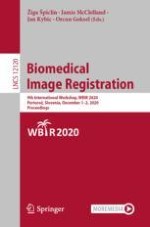This book constitutes the refereed proceedings of the 9th International Workshop on Biomedical Image Registration, WBIR 2020, which was supposed to be held in Portorož, Slovenia, in June 2020. The conference was postponed until December 2020 due to the COVID-19 pandemic.
The 16 full and poster papers included in this volume were carefully reviewed and selected from 22 submitted papers. The papers are organized in the following topical sections: Registration initialization and acceleration, interventional registration, landmark based registration, multi-channel registration, and sliding motion.
